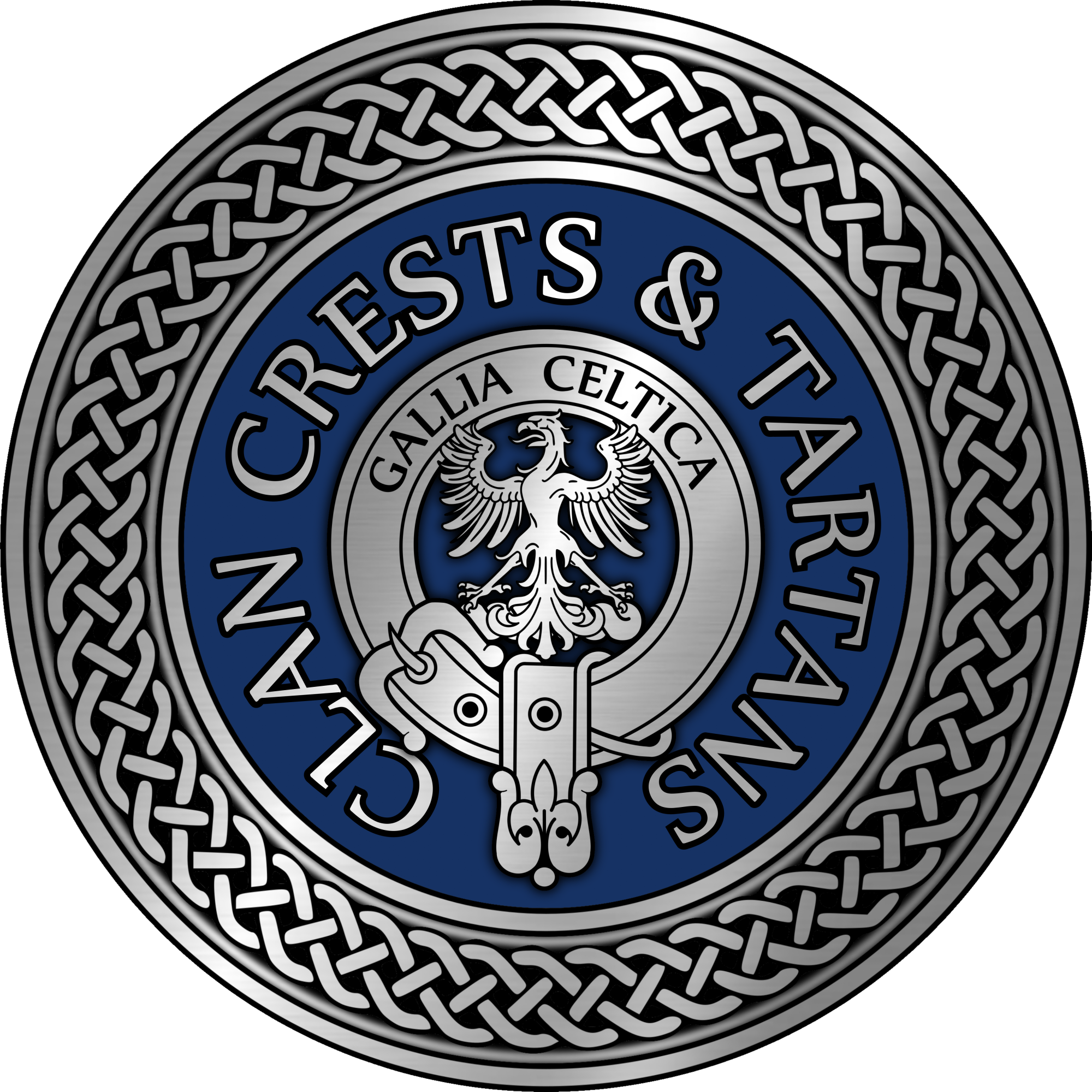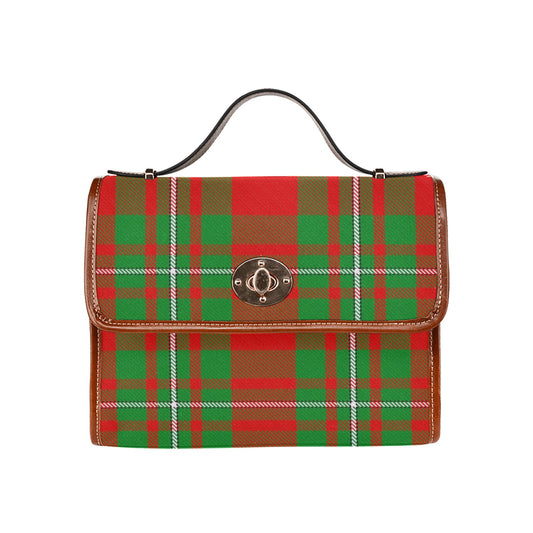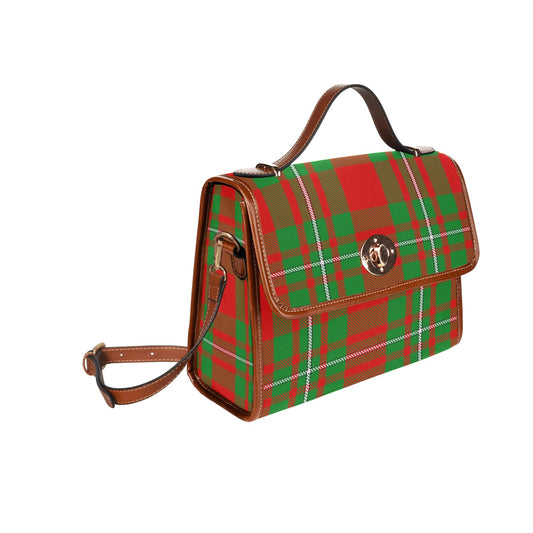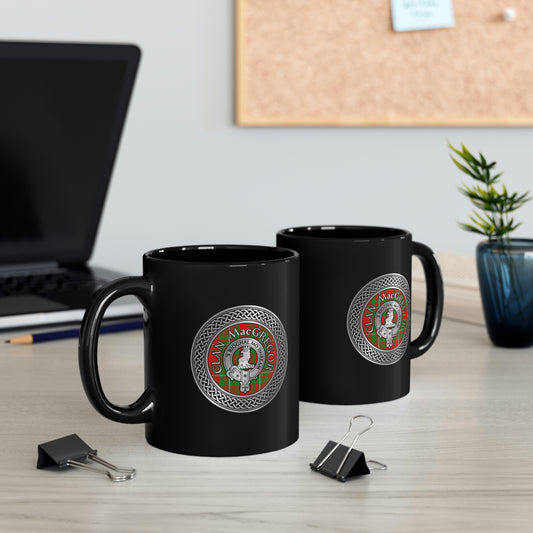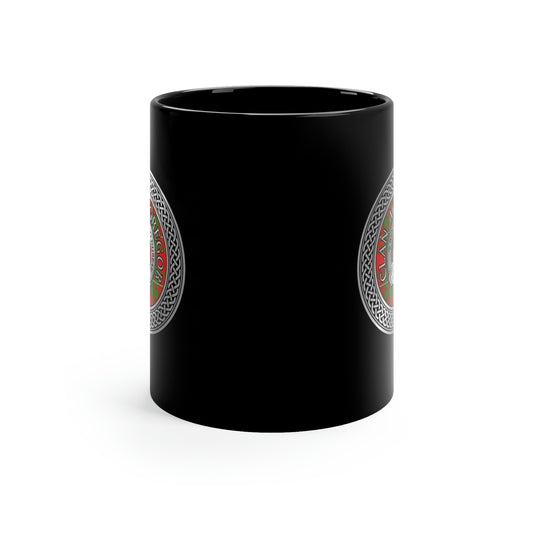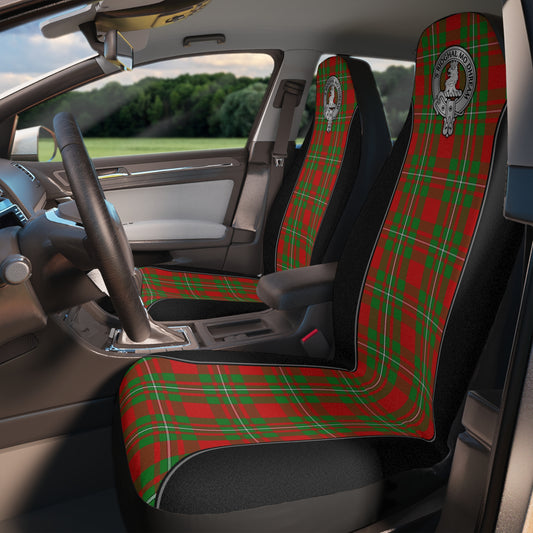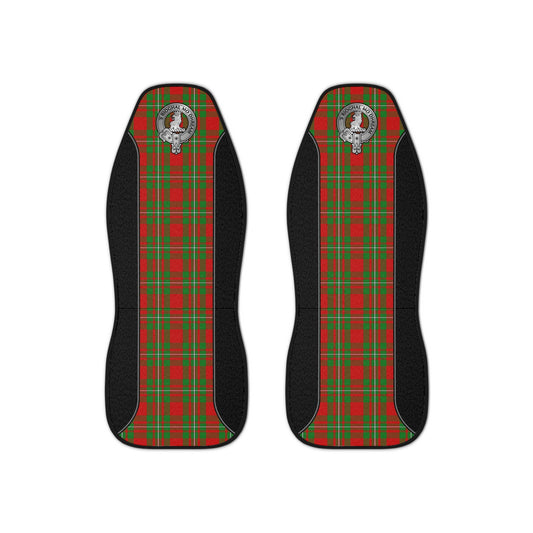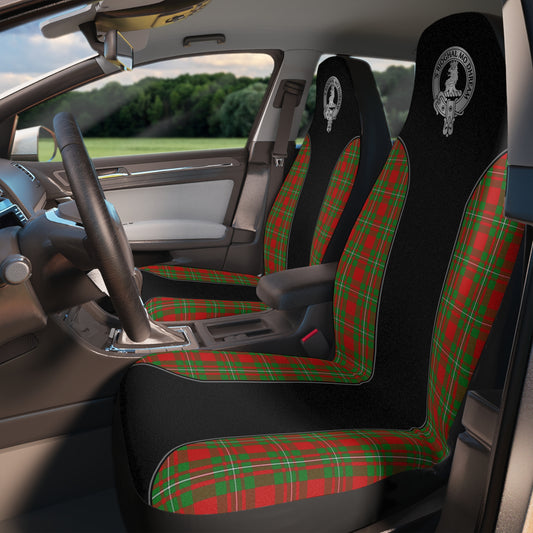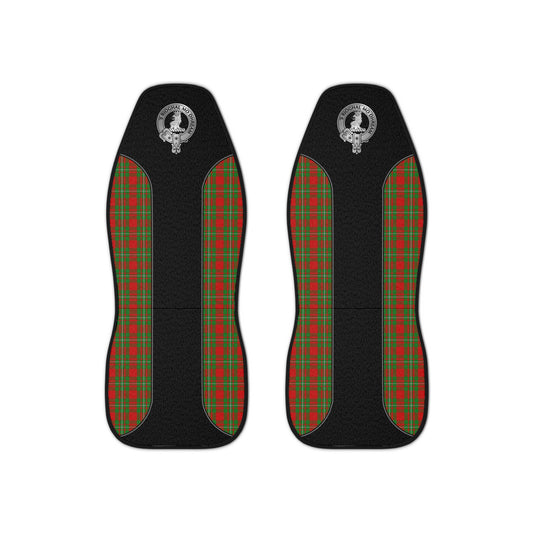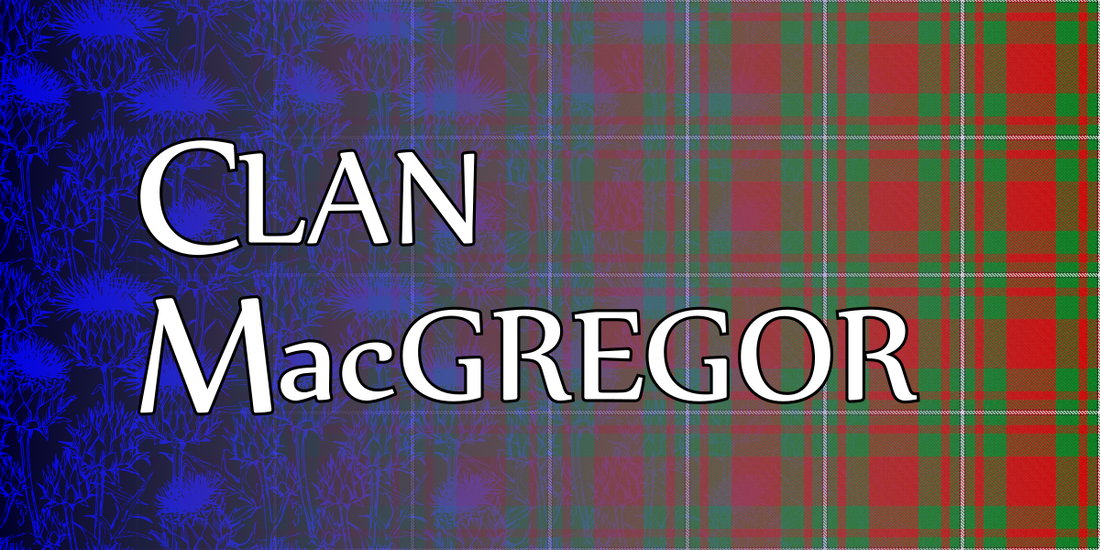

Scots Gaelic: Clann Ghriogair, na Griogalaich
Clan MacGregor an origin in the early 9th century.
The Clan is also known to have been among the first families of Scotland to begin playing the bagpipes n the early 17th century.
Profile
Crest: A lion's head erased Proper, crowned with an antique crown Or
Motto: 'S Rioghal mo dhream (Royal is my race)
Plant Badge: Scots pine
Region: Highlands
District: Argyll, Perthshire
Historic Seat: Boreland House
Chief: Sir Malcolm Gregor Charles MacGregor of MacGregor, 7th Baronet of Lanrick and Balquhidder, 24th Chief of Clan Gregor.
Clan Relationships
Branches
MacGregor of MacGregor (chiefs)
Greig (Russian nobility)
MacGregor of Balquhidder
MacGregor of Cardney
MacGregor of Glengyle
MacGregor of Glenstrae
Septs
Black, Comrie, Fletcher, Gregor, Gregorson, Gregory, Greig, Grier, Grierson, Grigor, King, Leckie, Macara, MacAdam, MacChoiter, Macaree, Macgruder, Macgrowther, Macilduy, MacLeister, MacLiver, MacNee, MacNeish, MacNie, MacNish, MacPeter, Malloch, Neish, White, Peter.
Allied Clans
Donnachaidh, MacFarlane, Grant, Lamont, Tailyour
Rival Clans
Campbell, Graham, MacLaren, Colquhoun, Drummond, MacThomas
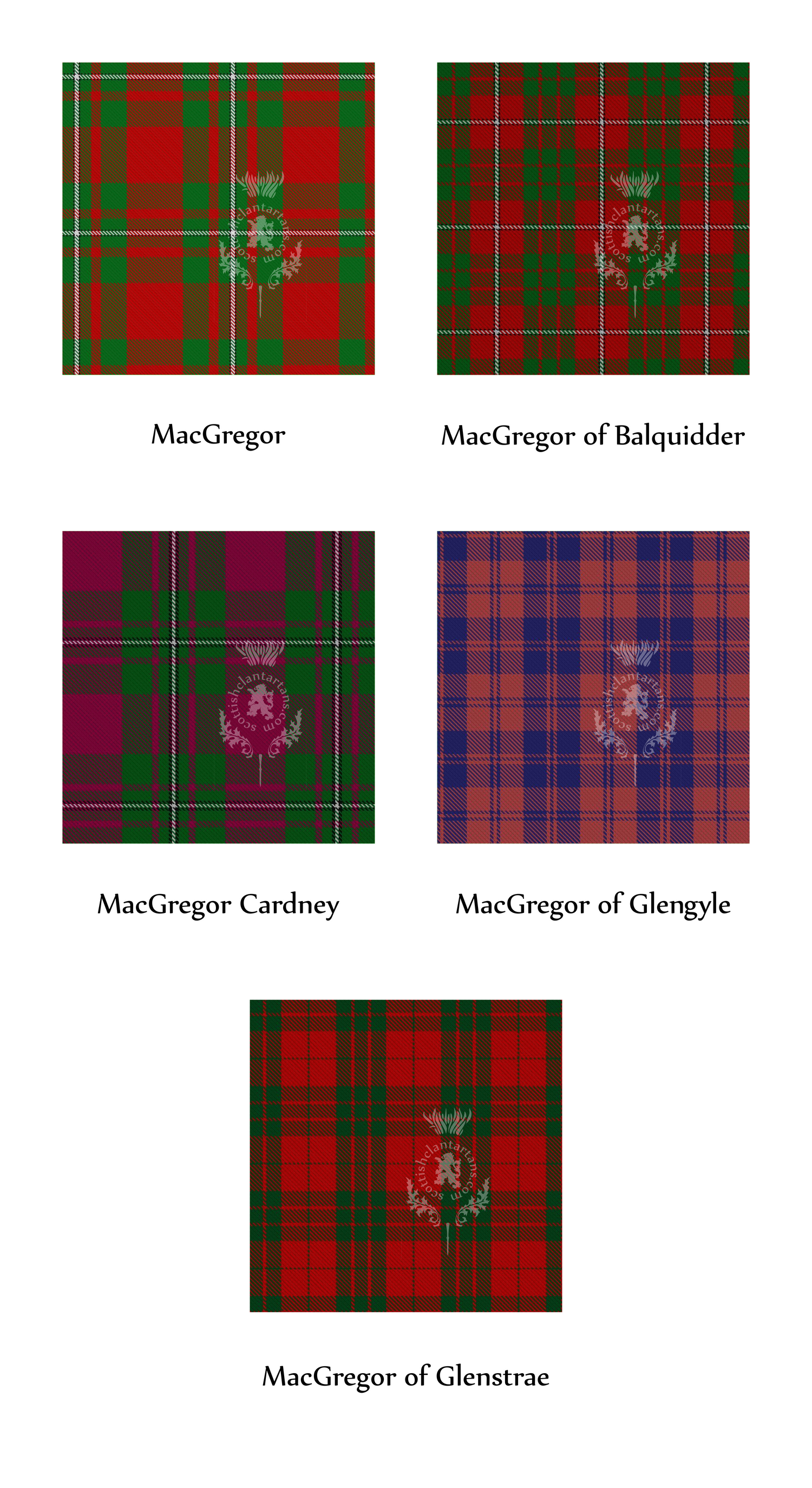
Clan Tartans
Shop MacGregor TartansClan History
The Clan Gregor held lands in Glen Orchy, Glenlochy and Glenstrae. According to Iain Moncreiffe the MacGregors were descended from an ancient Celtic royal family, through the Abbots of Glendochart. This is alluded to in the clan's motto: "Royal is my race". There is also a tradition that Gregor was the brother of Kenneth MacAlpin. Though there is little evidence to support this tradition, it is supported by the Scottish historian, William Skene. It is possible that the eponymous Gregor from whom the family derives may have been Griogair, son of Dungal, who was allegedly co-ruler of Alba.
Most modern historians agree that the first chief of Clan Gregor was Gregor of the golden bridles. His son was Iain Camm One eye, who succeeded as the second chief sometime before 1390.
The barony of Loch Awe which included much of the MacGregor lands was granted to the chief of Clan Campbell by Robert the Bruce. The Campbells had already built Kilchurn Castle which controlled the gateway to the western Highlands and they harried the MacGregors who were forced to retire deeper into their lands until they were restricted to Glenstrae.16th century and clan conflicts.
Iain of Glenstrae died in 1519 with no direct heirs. He was the second of his house to be called the Black. The succession of Eian was supported by the Campbells, and he married a daughter of Sir Colin Campbell of Glenorchy. In 1547 Eian's son, Alistair, fought against the English at the Battle of Pinkie Cleugh but died shortly after.
Colin Campbell refused to recognize the claim of Gregor Roy MacGregor to the estates, and for ten years Gregor waged a war against the Campbells. He was an outlaw who raided cattle and sheltered in the high glens. However, in 1570, he was captured and murdered by the Campbells. The chiefship was claimed by his son, Alistair, but he was unable to stem the Campbell's persecution of his kinsmen, who over time became known as the Children of the Mist, a name associated with the MacGregors due to the extent of their losses.
Additionally, John Drummond, of Clan Drummond was the king's forester and was subsequently killed after hanging a number of MacGregors for poaching. The chief took responsibility for the killing and it was condemned by the Privy Council.17th century, clan conflicts and civil war.
In response to the execution of two MacGregor clansmen in the year 1603, Alasdair MacGregor marched into Colquhoun territory with a force of over four hundred men. The chief of Clan Colquhoun, in response, had been granted a royal commission to suppress the MacGregors. Colquhoun assembled a force of five hundred foot and three hundred horse and advanced to Glen Fruin to repel the Highland raiders. MacGregor split his force in two and while the main MacGregor force and the Colquhouns engaged in combat, the second MacGregor force attacked the Colquhouns from the rear. The Colquhouns were driven into the Moss of Auchingaich where their cavalry was useless and over two hundred Colquhouns were killed. At the end of the eighteenth century, in an act of good will, the chiefs of the two clans met and shook hands on the very site of the former slaughter.
In April 1603 James VI of Scotland issued an edict that proclaimed the name of MacGregor as "altogidder abolisheed". This meant that anyone who bore the name must renounce it or suffer death. In 1604, MacGregor and eleven of his chieftains were hanged at Mercat Cross, Edinburgh. As a result, the Clan Gregor was scattered, with many taking other names such as Murray or Grant. They were hunted like animals and flushed out of the heather by bloodhounds.
An Edinburgh burgess, Robert Birrel, who kept a diary of events at the time, described the episode thus,
wes convoyit to Berwick be the Gaird to conforme to the Earl's promese: for he promesit to put him out of Scottis grund. Swahe keipit ane Hieland-manis promes; in respect he sent the Gaird to convoy him out of Scottis grund: But thai were not directit to pairt with him, but to fetche him bak agane! The 18 Januar, at evine , he come agane to Edinburghe; and upone the 20-day he wes hangit at the Croce, and xjof his freindis and name, upon ane gallous: Himself being Chieff, he wes hangit his awin hicht aboune the rest of hes freindis.
"An Act of the Scottish Parliament from 1617 stated (translated into modern English):It was ordained that the name of MacGregor should be abolished and that the whole persons of that name should renounce their name and take some other name and that they nor none of their name and that they nor none of their posterity should call themselves Gregor or MacGregor under pain of death ... that any person or persons of the said clan who has already renounced their names or hereafter shall renounce their names or if any of their children or posterity shall at any time hereafter assume or take to themselves the name of Gregor or MacGregor ... that every such person or persons assuming or taking to themselves the said name ... shall incur the pain of death which pain shall be executed upon them without favour.
Clan Lamont of Cowal defied this and provided aid and refuge for fleeing MacGregors in their lands in the wake of the persecution. Despite the savage treatment of the MacGregors, they had nevertheless fought for the king during the Scottish Civil War. Two hundred men of the Clan Gregor fought for the Earl of Glencairn in what was known as Glencairn's rising, against the Commonwealth. In recognition of this, Charles II of England repealed the proscription of the name, but William of Orange reimposed it when Charles's brother James VII was deposed.
MacGregor Collection
These fantastic products incorporate the Clan MacGregor crests & tartans.
The collection is growing, and as standard the clan name is displayed as "MacGregor". If you have a preference to use a sept name, contact us, and time permitting we'll add specific names.
Septs of Clan MacGregor:
Black, Comrie, Fletcher, Gregor, Gregorson, Gregory, Greig, Grier, Grierson, Grigor, King, Leckie, Macara, MacAdam, MacChoiter, Macaree, Macgruder, Macgrowther, Macilduy, MacLeister, MacLiver, MacNee, MacNeish, MacNie, MacNish, MacPeter, Malloch, Neish, White, Peter
-
Clan MacGregor Canvas Handbag
Regular price $49.99 USDRegular priceUnit price per -
Clan MacGregor Crest & Tartan 11oz Black Mug
Regular price $16.95 USDRegular priceUnit price per -
Clan MacGregor Crest & Tartan Car Seat Covers
Regular price $69.95 USDRegular priceUnit price per -
Clan MacGregor Crest & Tartan Car Seat Covers
Regular price $69.95 USDRegular priceUnit price per
18th Century and Jacobite Risings
Rob Roy MacGregor was born in 1671, a younger son of MacGregor of Glengyle. (However, given the circumstances, he had been forced to assume his mother's surname of Campbell). The adventures of Rob Roy MacGregor have been immortalized and romanticized by Sir Walter Scott in his novel Rob Roy. Rob Roy was undoubtedly a thorn in the flesh of the government until he died in 1734. He supported the Jacobite cause in 1715 and after the Battle of Sheriffmuir he set out plundering at will. In one such raid on Dumbarton, the town was put into panic and Dumbarton Castle was forced to open fire with its cannon. He also led Clan Gregor at the Battle of Glen Shiel in 1719. He is buried in Balquhidder churchyard.
During the 1745 uprising, some of Clan Gregor fought at the Battle of Prestonpans with the Jacobite army under the Duke of Perth. Some of Clan Gregor were among the Jacobite force that was defeated at the Battle of Littleferry in 1746 in Sutherland, and therefore missed the Battle of Culloden that took place the next day and which they would have been too late. After the rising, when the MacGregors were returning home, no-one ventured to interfere with them when they strode across Atholl, with their flying colours they strode passed Finlairg Castle where according to one source the Clan Campbell militia "durst not move more than pussies", and the MacGregors defying in broad daylight the outposts which Lord Campbell of Glenorchy had established in the passes.
Persecution of the MacGregors did not end until 1774, when the laws against them were repealed.
19th Century and Restored Clan
To restore pride in the clan, the chiefs needed to be re-established. Eight hundred and twenty six MacGregors subscribed to a petition declaring General John Murray of Lanrick to be the true chief. Murray was in fact a MacGregor who was descended from Duncan MacGregor of Ardchoille, who had died in 1552. His son was Sir Evan, who played a part in the visit of George IV to Scotland in 1822, where he and his clansmen were given the tremendous honour of guarding the Honours of Scotland, better known as the Scottish Regalia and the oldest set of crown jewels in the British Isles.
